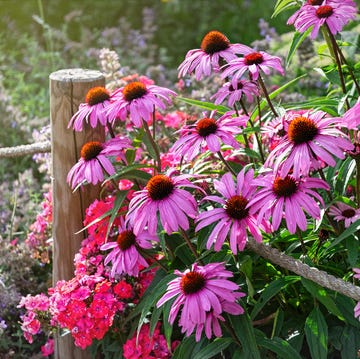Deciding between artificial turf and natural grass for your lawn? You’re not alone. With rising water costs, extreme heat, and growing environmental concerns, many homeowners are seriously weighing the pros and cons of each option. Whether you're tired of mowing your lawn every weekend or dreaming of a perfect yard that doesn’t develop brown patches in the summer, the choice between turf vs. grass isn’t always as simple as it seems. To help you make the best decision, Tom Smith, the owner of Desert Designer Landscape and Development in Tempe, Arizona, is here to get the real dirt on what to expect from both.
What Are the Biggest Advantages of Artificial Grass?
If you’re tired of mowing, watering, and fertilizing your lawn, artificial grass might feel like a dream come true. “The three biggest advantages to installing artificial grass are saving money on your water bill, eliminating yard maintenance, and never worrying about grass dying,” says Smith. Natural lawns can be unpredictable and require different care throughout the year. Artificial grass, on the other hand, stays green with minimal effort.
“You’re not buying fertilizer or gas for your mower, and you’re not dealing with lousy soil or pests,” Smith adds. Over time, these savings can add up, making artificial grass a smart long-term investment.
Are There Any Misconceptions About Artificial Turf?
A lot of people assume artificial grass stays cool in the summer, but that’s not the case. “People think artificial grass feels like natural grass in the heat, but it’s more like carpet or concrete,” Smith explains. On hot days, artificial grass can get uncomfortably warm—so if the kids or pets are about to play on it, you’ll need to hose it down to cool it off.
Another misconception is the maintenance. While artificial grass doesn’t require mowing, Smith recommends regular cleaning. “If you have pets, hose it down once a week. If not, once a month is fine,” he says. For lingering odors, use an artificial grass cleaner or a vinegar-and-water mix.
How Does Artificial Grass Impact the Environment?
When it comes to water conservation, artificial grass is a win. For homeowners in drought-prone areas, reducing water use can make a big difference, Smith notes. “In Arizona, where I work, water is a precious resource, so limiting water usage is a huge benefit,” he says.
However, there’s a downside when it’s time to replace the turf. “A lot of old turf ends up in landfills,” Smith notes. While some manufacturers are working toward more sustainable options, artificial grass isn’t biodegradable, which means it sticks around long after its lifespan.
What Should You Consider Before Installing Artificial Grass?
Artificial grass is an investment, and it takes time to see the financial benefits. “How long are you going to be in your home?” asks Smith. “It usually takes three to six years to pay off the installation costs, depending on your water usage.”
If you plan to stay in your home for a decade or more, artificial grass can be worth it. But if you’re moving in a few years, you might not get enough return on your investment to justify the upfront cost. “Think long-term before you commit,” Smith advises.
How Long Does Artificial Grass Last and What Maintenance Is Required?
With proper care, artificial grass can last up to 20 years. “If you maintain it properly, it will hit the 20-year mark. If not, you’re looking at closer to 10 years,” says Smith. Basic maintenance includes sweeping or brushing to keep the blades upright, hosing it down regularly, and checking for weeds.
“If you have pets, pick up waste right away and give it a good rinse,” Smith suggests. He also recommends a professional deep clean once a year or every other year. “A pro can reset your artificial grass to a reasonable baseline and catch any bigger issues before they become a problem.”
Is Artificial Grass Right for You?
Ultimately, choosing between turf and grass depends on your lifestyle and how much time and money you’re willing to invest in your yard. Artificial grass offers a low-maintenance, water-saving solution that stays green year-round, but it does come with higher upfront costs and potential environmental concerns.
As Smith puts it, “Artificial grass is about long-term savings and convenience. If you’re ready for that trade-off, it’s a great option.”

Tierney McAfee is a freelance writer and Country Living and The Pioneer Woman contributor who covers entertainment, holiday & entertaining, food & drinks, design ideas, DIY, and more.













